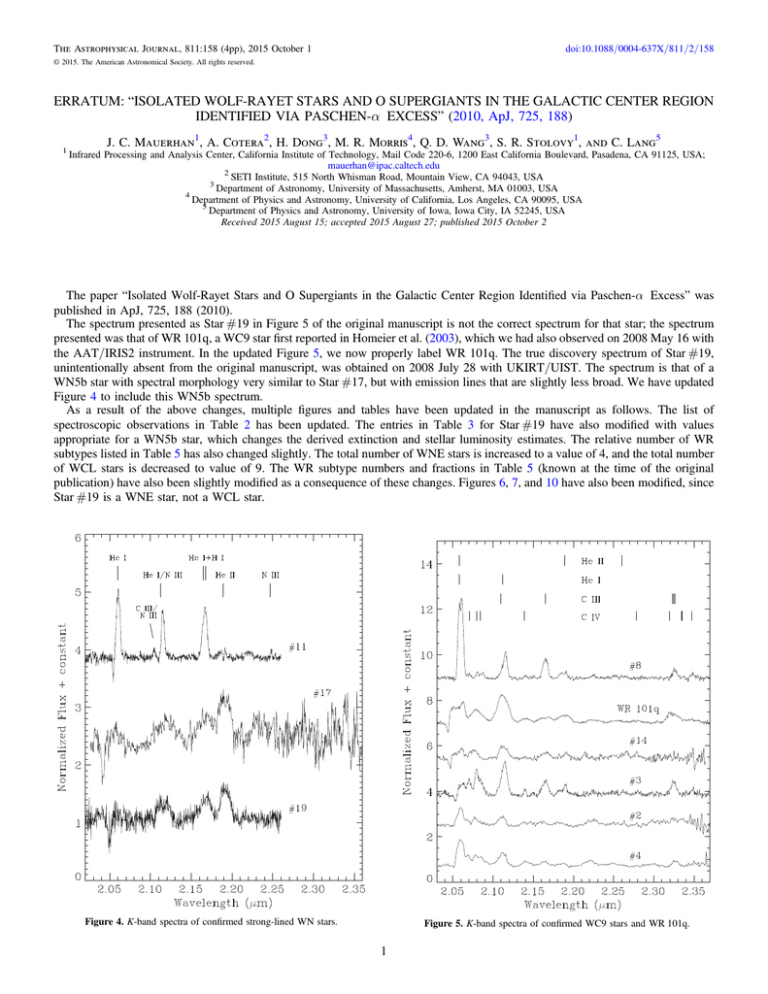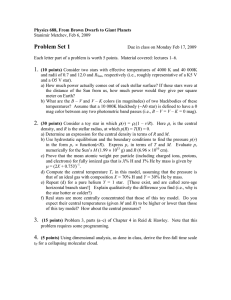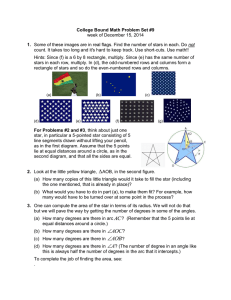
The Astrophysical Journal, 811:158 (4pp), 2015 October 1
doi:10.1088/0004-637X/811/2/158
© 2015. The American Astronomical Society. All rights reserved.
ERRATUM: “ISOLATED WOLF-RAYET STARS AND O SUPERGIANTS IN THE GALACTIC CENTER REGION
IDENTIFIED VIA PASCHEN-α EXCESS” (2010, ApJ, 725, 188)
J. C. Mauerhan1, A. Cotera2, H. Dong3, M. R. Morris4, Q. D. Wang3, S. R. Stolovy1, and C. Lang5
1
Infrared Processing and Analysis Center, California Institute of Technology, Mail Code 220-6, 1200 East California Boulevard, Pasadena, CA 91125, USA;
mauerhan@ipac.caltech.edu
2
SETI Institute, 515 North Whisman Road, Mountain View, CA 94043, USA
3
Department of Astronomy, University of Massachusetts, Amherst, MA 01003, USA
4
Department of Physics and Astronomy, University of California, Los Angeles, CA 90095, USA
5
Department of Physics and Astronomy, University of Iowa, Iowa City, IA 52245, USA
Received 2015 August 15; accepted 2015 August 27; published 2015 October 2
The paper “Isolated Wolf-Rayet Stars and O Supergiants in the Galactic Center Region Identified via Paschen-α Excess” was
published in ApJ, 725, 188 (2010).
The spectrum presented as Star #19 in Figure 5 of the original manuscript is not the correct spectrum for that star; the spectrum
presented was that of WR 101q, a WC9 star first reported in Homeier et al. (2003), which we had also observed on 2008 May 16 with
the AAT/IRIS2 instrument. In the updated Figure 5, we now properly label WR 101q. The true discovery spectrum of Star #19,
unintentionally absent from the original manuscript, was obtained on 2008 July 28 with UKIRT/UIST. The spectrum is that of a
WN5b star with spectral morphology very similar to Star #17, but with emission lines that are slightly less broad. We have updated
Figure 4 to include this WN5b spectrum.
As a result of the above changes, multiple figures and tables have been updated in the manuscript as follows. The list of
spectroscopic observations in Table 2 has been updated. The entries in Table 3 for Star #19 have also modified with values
appropriate for a WN5b star, which changes the derived extinction and stellar luminosity estimates. The relative number of WR
subtypes listed in Table 5 has also changed slightly. The total number of WNE stars is increased to a value of 4, and the total number
of WCL stars is decreased to value of 9. The WR subtype numbers and fractions in Table 5 (known at the time of the original
publication) have also been slightly modified as a consequence of these changes. Figures 6, 7, and 10 have also been modified, since
Star #19 is a WNE star, not a WCL star.
Figure 4. K-band spectra of confirmed strong-lined WN stars.
Figure 5. K-band spectra of confirmed WC9 stars and WR 101q.
1
The Astrophysical Journal, 811:158 (4pp), 2015 October 1
Mauerhan et al.
Table 1
Basic Data for New Emission-line Stars
No.
R.A.
Name
Decl.
J
(mag)
(deg, J2000)
1
2
3
4
5b
6
7
8
9
10
11
12
13
14
15
16
17
18
19
K
G359.797+0.037
G359.717−0.044
G359.746−0.090
G359.691−0.072
G359.907−0.001b
G359.973−0.008
G359.925−0.049
G359.866−0.062
G0.070+0.025
G0.058+0.014
G0.114+0.021
G0.124+0.007
G0.059−0.068
G0.076−0.062
G0.071−0.096
G0.121−0.099
G0.202−0.076
G0.238−0.071
G0.007−0.052
G0.120−0.048a
266.247738
266.279460
266.341231
266.290860
266.350673b
266.381294
266.408263
266.385493
266.422032
266.426394
266.452572
266.472510
266.506989
266.510914
266.541810
266.573243
266.599325
266.615120
266.460700
266.523436
−29.090525
−29.200125
−29.199841
−29.236897
−29.016080b
−28.954669
−29.026258
−29.082757
−28.863311
−28.879828
−28.828510
−28.827035
−28.920983
−28.903941
−28.925694
−28.884391
−28.803129
−28.770077
−28.957282
−28.858866
H
(mag)
8.715 ± 0.023
16.842 ± 0.073
K
15.555 ± 0.030
K
15.131 ± 0.021
11.052 ± 0.037
K
14.799 ± 0.016
14.704 ± 0.016
K
15.367 ± 0.021
13.450 ± 0.014
16.396 ± 0.038
14.984 ± 0.021
14.972 ± 0.018
16.330 ± 0.047
14.370 ± 0.018
15.801 ± 0.031
12.53 ± 0.03
7.590
13.526
14.672
13.019
13.454
12.677
9.578
14.621
11.600
11.666
13.612
12.535
10.687
13.478
12.273
12.053
13.265
11.291
12.933
9.24
±
±
±
±
±
±
±
±
±
±
±
±
±
±
±
±
±
±
±
±
0.038
0.019
0.029
0.015
0.033b
0.012
0.044
0.022
0.013
0.013
0.025
0.017
0.011
0.017
0.017
0.014
0.011
0.012
0.031
0.02
Ks
(mag)
7.030
11.112
12.703
11.140
11.364
11.366
8.898
12.016
9.858
10.110
11.136
11.003
9.122
11.608
10.788
10.459
11.434
9.549
11.339
7.46
±
±
±
±
±
±
±
±
±
±
±
±
±
±
±
±
±
±
±
±
0.013
0.026
0.028
0.018
0.081b
0.017
0.119
0.014
0.011
0.028
0.013
0.013
0.046
0.016
0.016
0.018
0.019
0.042
0.015
0.02
F190N
(mJy)
1088.79
12.58
3.75
12.33
103.74
15.28
185.76
5.42
48.43
37.81
12.57
19.20
109.86
8.67
22.50
29.98
11.68
69.06
13.05
918
±
±
±
±
±
±
±
±
±
±
±
±
±
±
±
±
±
±
±
±
17.10
0.20
0.06
0.28
1.63
0.24
2.92
0.09
1.08
0.84
0.20
0.30
1.73
0.16
0.35
0.47
0.18
1.09
0.21
14
F187N/F190N
1.28
1.27
1.88
1.48
1.17
1.10
1.05
1.80
1.19
1.33
1.90
1.25
1.22
2.36
1.27
1.46
2.59
1.28
2.52
1.32
±
±
±
±
±
±
±
±
±
±
±
±
±
±
±
±
±
±
±
±
0.03
0.03
0.05
0.05
0.03
0.03
0.02
0.04
0.04
0.04
0.04
0.03
0.03
0.06
0.03
0.03
0.06
0.03
0.06
0.03
Notes. Positions and JHKs photometry are from IRSF SIRIUS observations of the Galactic center (Nishiyama et al. 2006), except for star 1 and 7, which correspond to
2MASS J17445945−2905258 and 2MASSJ17453798−2901345, respectively (Cutri et al. 2003). The HST/NICMOS narrowband F187N and F190N measurements
are from Dong et al. (in preparation).
a
This source is the LBV G0.120−0.048 from Mauerhan et al. (2010b). The JHKs values for this source are from 2MASS. The narrowband measurements
reported here are refined values that were extracted from the same data, owing to a recent improvement in the photometry extraction method of Dong et al. (in
preparation). In addition, the F190N and F190N/F187N measurements that were presented by Mauerhan et al. (2010b) for the Pistol Star and qF362 should be
updated to 988 ± 18 mJy and 1.21 ± 0.03 for the Pistol Star, and 740 ± 13 mJy and 1.02 ± 0.03 for qF362.
b
Star #5 is blended with a neighboring star in IRSF/SIRIUS images; photometry and astrometry unreliable.
Table 2
Spectroscopic Observations
Star
Observation Date (UT)
Telescope/Instrument
λ/δλ
1
2
3
4
5
6
7
8
9
10
11
12
13
14
15
16
17
18
19
2009 Aug 4 07:31
2009 June 13 07:20
2009 Aug 4 08:06
2009 June 13 05:29
2007 Aug 1 08:30
2010 May 24 06:52
2010 May 27 10:23
2009 Aug 4 07:42
2007 Aug 1 09:05
2007 Aug 1 06:36
2008 Jul 31 09:10
2007 Aug 1 05:57
2008 Jun 17 09:19
2008 May 16 14:00
2009 Aug 4 08:40
2008 May 14 19:37
2008 May 16 15:45
2008 Jun 13 01:10
2008 Jul 28 06:48
IRTF/SpeX
SOAR/OSIRIS
IRTF/SpeX
SOAR/OSIRIS
UKIRT/UIST
SOAR/OSIRIS
SOAR/OSIRIS
IRTF/SpeX
UKIRT/UIST
UKIRT/UIST
UKIRT/UIST
UKIRT/UIST
SOAR/OSIRIS
AAT/IRIS2
IRTF/SpeX
AAT/IRIS2
AAT/IRIS2
SOAR/OSIRIS
UKIRT/UIST
2000
1200
1200
1200
2133
1200
1200
1200
2133
2133
2133
2133
3000
2400
1200
2400
2400
1200
2133
Figure 6. Near-infrared color-color diagram of new WN, WC, and OB stars
(green squares, red circles, and blue triangles, respectively). The small dots are
random field stars. All of the massive stars exhibit infrared excess, mainly
attributable to free-free and line emission from their dense, ionized winds. The
WC9 stars may be sources of an additional excess component of thermal
emission from hot dust. A color version of this figure is available in the online
journal.
2
The Astrophysical Journal, 811:158 (4pp), 2015 October 1
Mauerhan et al.
Table 3
Extinction and Absolute Photometry for Selected Stars
Star
Spectral
Type
Ks
(mag)
(J - Ks )0
(mag)
(H - Ks )0
(mag)
AKJs- Ks
(mag)
AKHs- Ks
(mag)
AKs
(mag)
MKs
(mag)
BCKa
(mag)
Lbol
(log Le)
1
2
3
4
5
6
7
8
9
10
11
12
13
14
15
16
17
18
19
B0I–B2I
WC9?d
WC9
WC9?d
B0I–B2I
O4–6I
O4–6I
WC9
O4–6If+
O4–6If+
WN8–9 h
WN8–9 h
P Cyg-type OI
WC9
WN8–9 h
WN8–9 h
WN5b
P Cyg-type OI
WN5b
7.03
11.11
12.70
11.14
11.36d
11.37
8.90
12.02
9.86
10.11
11.14
11.00
9.12
11.61
10.79
10.46
11.43
9.55
11.34
−0.21
0.23
0.23
0.23
−0.21
−0.21
−0.21
0.23
−0.21
−0.21
0.13
0.13
−0.21
0.23
0.13
0.13
0.36
−0.21
0.36
−0.10
0.26
0.26
0.26
−0.10
−0.10
−0.10
0.26
−0.10
−0.10
0.11
0.11
−0.10
0.26
0.11
0.11
0.26
−0.10
0.26
0.94
2.91
K
2.21
K
1.96
1.17
K
2.54
2.37
K
2.09
2.24
2.41
2.01
2.17
2.40
3.37
2.03
0.96
2.86
4.06
2.15
3.16d
2.05
1.14
3.12
2.67
2.40
3.41
2.05
2.41
2.14
1.98
2.24
2.09
3.35
1.92
0.95b
2.89
4.06
2.18
3.16d
2.01
1.16b
3.12
2.61
2.39
3.41
2.07
2.33
2.28
2.00
2.15
2.24
3.36
1.98
−6.71b
−6.28
−5.86
−5.54
−6.30d
−5.14
−5.14b
−5.60
−7.25
−6.78
−6.77
−5.57
−7.71
−5.17
−5.71
−6.19
−5.31
−8.31
−5.31
−3.7
−3.6
−3.6
−3.6
−3.7
−4.3
−4.3
−3.6
−4.3
−4.3
−4.2
−4.2
−3.7
−3.6
−4.2
−4.2
−4.4
−3.7
−4.4
6.06b
5.85b
5.68
5.56c
5.90d
5.68
5.68b
5.58
6.52
6.33
6.29
5.81
6.46
5.41
5.86
6.06
5.54
6.70
4.96
Notes.
a
Bolometric corrections were derived from Martins et al. (2008) for WN8–9 h stars; from Crowther et al. (2006) for other WRs; and from Martins et al. (2006) for the
OB stars.
b
The relatively low value of extinction for the O4–6I star 7 and B0I–B2I star 1, compared to the other stars in this table, implies that they are located in the
foreground. We estimated the distance to 7 (O4–6I) by adopting MKs and Lbol from the similar O4–6I star 6. The resulting distance modulus is 12.79 mag (3.6 kpc),
which implies that 7 lies in the Norma arm of the Galaxy (Churchwell et al. 2009). Since 1 has an extinction that is comparable to 7, one might also assume that these
stars have comparable distances. If so, this implies 1 has MKs = -6.71 mag, which means it is a supergiant.
c
These values may be erroneously high. The color–color diagram in Figure 6 implies that these stars may emit thermal excess from hot dust, in which case the
extinction cannot be reliably derived using the near-infrared colors.
d
As noted in Table 1, Star #5 is blended with a neighboring star in the IRSF/SIRIUS images; photometry unreliable.
Table 5
Distribution of WR Subtypes in the GCR
Group
GCR “Isolated”
Arches
Quintuplet
Central
GCR Total
WNE
WNL
WCE
WCL
WRtot
WC/WN
WCL/WC
WC/WRtot
References
4
0
1
1
6
15
13
5
17
50
0
0
0
1
1
9
0
14
12
35
28
13
20
31
92
0.47
n/a
2.33
0.72
0.66
1.00
0.00
1.00
0.92
0.97
0.32
0.00
0.70
0.42
0.39
1, 2, 3, 4, 5, 6, 12
7, 11
2, 4, 8, 9
10
K
References. (1) This work; (2) Mauerhan et al. (2010a); (3) Cotera et al. (1999); (4) Homeier et al. (2003); (5) Muno et al. (2006); (6) Mikles et al. (2006); (7) Figer
et al. (2002); (8) Liermann et al. (2009); (9) Figer et al. (1999); (10) Paumard et al. (2006); (11) Martins et al. (2008); (12) Hyodo et al. (2008). Note that Stars 11, 12,
and G0.10 + 0.02, shown in Figure 8 of the original manuscript, have been designated as “isolated” stars for this table, even though they are likely to be be associated
with the Arches cluster.
3
The Astrophysical Journal, 811:158 (4pp), 2015 October 1
Mauerhan et al.
Figure 7. Observed line strength (F187N/F190N) vs. Ks-band SIRIUS magnitude for unidentified candidate Pα-excess sources (crosses), and for confirmed massive
stars. The brightest known sources (Ks 8 mag), which are saturated in the SIRIUS catalog, were plotted using their 2MASS photometry. The figure includes objects
from the Arches, Quintuplet, and Central Parsec clusters, and from the GCR field. Stars are marked according to their approximate spectral type, defined in the legend
at the upper right of the figure. The brightness distribution of unidentified sources suggests that the sample of WN types in the survey might be near completion.
Figure 10. HST/NICMOS Pα survey image of the Galactic center region from Wang et al. (2010). The positions of the isolated massive stars are marked (i.e., those
located outside of the known extent of the Arches, Quintuplet, or Central clusters) and color coded according to spectral type (see the image legend). The discoveries
of this work (circles) are marked separately from the known sources (crosses). The two foreground O stars are labeled “FG”. Bona fide cluster members are not
marked.
Finally, we note that the SIRIUS photometry of Star #5 presented in Table 1 is contaminated by a neighboring star and is thus
confusion limited. Thus, In Tables 1 and 3, the photometry, astrometry, derived extinction, and luminosity are not reliable for
this star.
REFERENCES
Martins, F., Hillier, D. J., Paumard, T., et al. 2008, A&A, 478, 219
Mauerhan, J. C., Cotera, A., Dong, H., et al. 2010b, ApJ, 725, 188
Mauerhan, J. C., Muno, M. P., Morris, M. R., Stolovy, S. R., & Cotera, A.
2010a, ApJ, 710, 706
Mikles, V. J., Eikenberry, S. S., Muno, M. P., Bandyopadhyay, R. M., &
Patel, S. 2006, ApJ, 651, 408
Muno, M. P., Bower, G. C., Burgasser, A. J., et al. 2006, ApJ, 638, 183
Paumard, T., Genzel, R., Martins, F., et al. 2006, ApJ, 643, 1011
Wang, Q. D., Dong, H., Cotera, A., et al. 2010, MNRAS, 402, 895
Cotera, A. S., Simpson, J. P., Erickson, E. F., et al. 1999, ApJ, 510, 747
Figer, D. F., McLean, I. S., & Morris, M. 1999, ApJ, 514, 202
Figer, D. F., Najarro, F., Gilmore, D., et al. 2002, ApJ, 581, 258
Homeier, N. L., Blum, R. D., Pasquali, A., Conti, P. S., & Damineli, A. 2003,
A&A, 408, 153
Hyodo, Y., Tsujimoto, M., Koyama, K., et al. 2008, PASJ, 60, 173
Liermann, A., Hamann, W.-R., & Oskinova, L. M. 2009, A&A, 494, 1137
4




